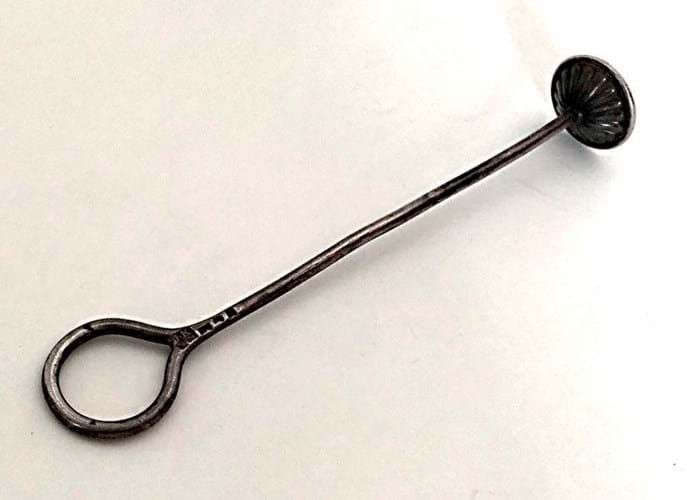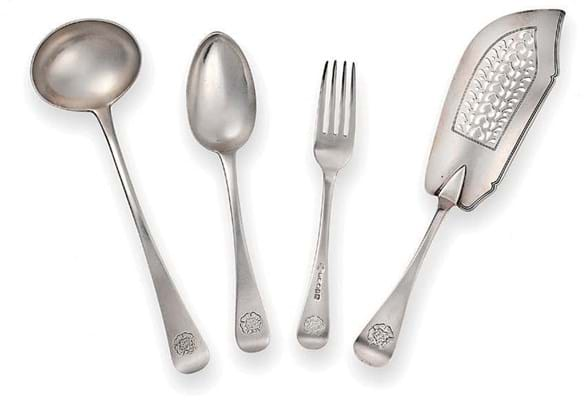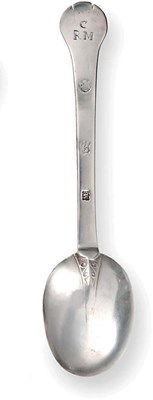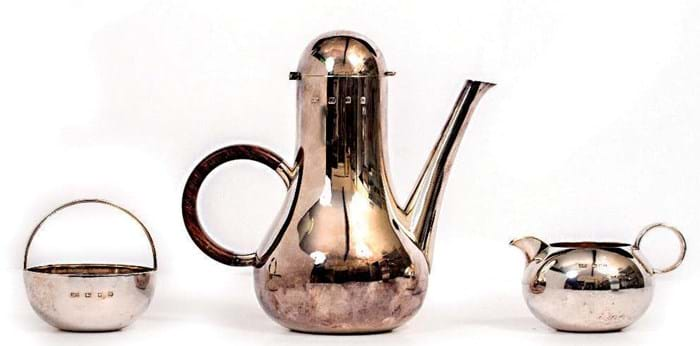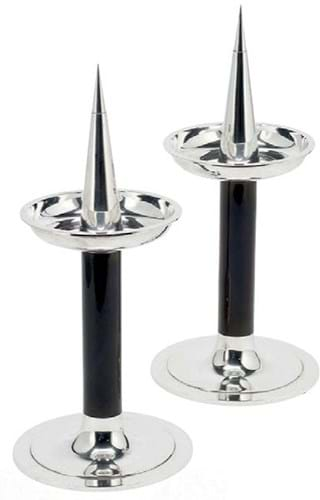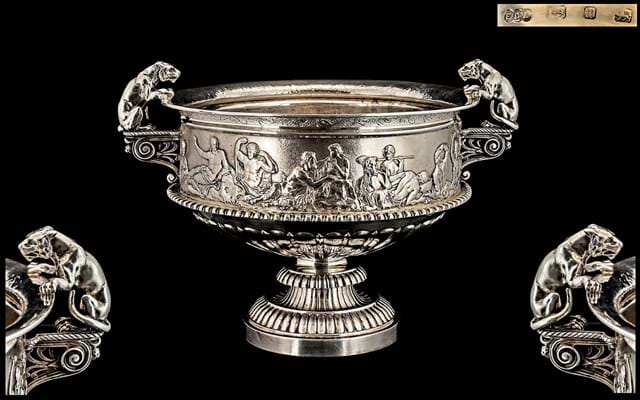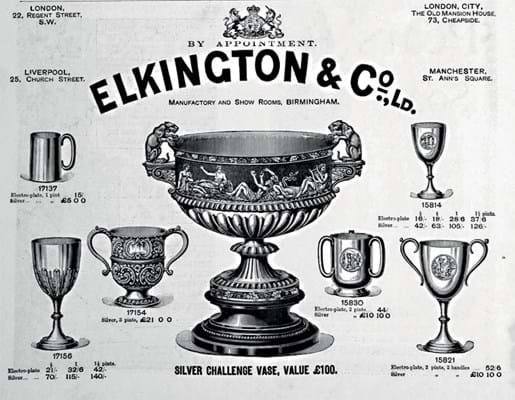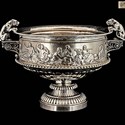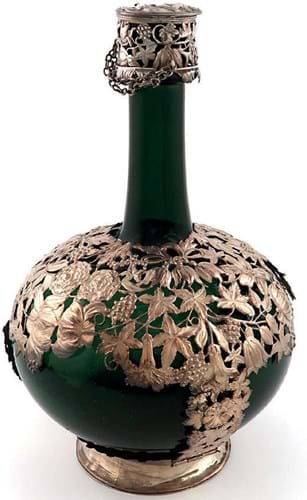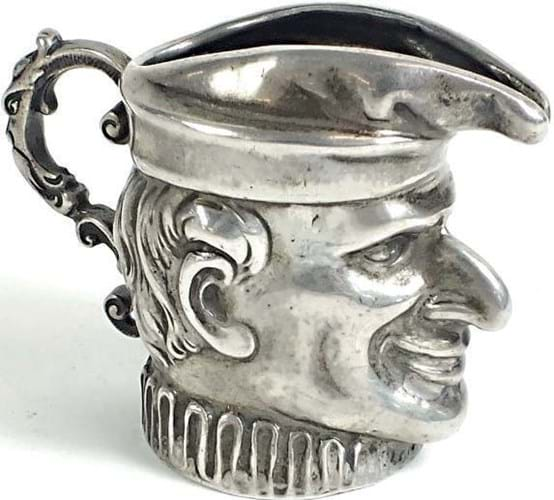Maltese survivor
Although the island supported a surprisingly large number of silversmiths in the 17th and 18th centuries, relatively little silver survived in Malta. Much was melted down under Napoleon while other pieces left the island as maritime souvenirs. A premium is now placed on the few survivors.
The sale at Catherine Southon (18% buyer’s premium) in Surrey on June 10 included a 5in (12cm) sugar bowl and cover: a typical circular bellied form, embossed with shells, scrolls and foliate decoration, and fitted with a flower bud finial. Maltese silver is categorised according to the name of the reigning Grand Master of the Order of St John. This piece, struck with the maker’s mark MA and an eight-pointed star, dates from the Ramón Perellós period (1697-1720).
It was not in great condition. The cover has a cut-out section to allow for a spoon and repairs had been made to several cracks. In this context the hammer price of £4000 (estimate £300-500) was a punchy number.
One lump or two?
This scarce piece of late Georgian flatware marked for JK, Sheffield 1825, is a sugar crusher – used to help dissolve lumps into warm drinks and liquids. They are more commonly seen in glass. This example has a simple loop handle, plain stem and a base cut to the underside with small teeth to help hold the sugar in place. At Whittons (18% buyer’s premium) in Honiton on June 4, it took £300.
Courtesy of York assay office
The specialist Jewellery, Watches & Silver sale at Tennants (20% buyer’s premium) in Leyburn on June 27 included a collection of spoons and flatware made by York silversmiths. The assay office in York, identified by several different town marks, was open periodically from the 16th century until it was finally closed in 1838.
The final York mark was the St George’s cross charged with five lions passant – seen on the 21 pieces of Old English pattern flatware from the Yorkshire Club Service made by James Barber and William North in 1838.
The part service comprised six table forks and spoons plus a pair of basting spoons, a fish slice, sauce ladle, soup ladle, sugar-tongs and mustard and salt spoons. Each was engraved with the Yorkshire Rose.
The service, used at the Yorkshire Club for a century, was dispersed by Christie’s in 1969. Typically offered as single elements, this group pitched at £600-800 took £3800.
Also from this last incarnation of York silver was a rare apple corer with marks for James Barber and William Whitwell (probably c.1820) which sold at £900.
The mark used by York smiths towards the end of the 17th century was the half-seeded rose. A good example of this was cleanly struck to a Charles II trefid spoon with scroll decorated ribbed rat tail by Marmaduke Best, 1680. Engraved to the terminal with the initials CRM, it took £2200.
A trio of great British post-war silversmiths
A silver and parcel gilt chalice and cover by the Australian silversmith Stuart Devlin sold for £5000 at Kingham & Orme (23% buyer’s premium) in Evesham on May 29.
Thought to be a unique piece hallmarked for London 1973, it was made in the key era between 1965, when Devlin first moved to London, and 1979 when the opening of a showroom in Conduit Street necessitated something akin to mass production.
It was this period that marked the beginning of Devlin’s own style, the debut of the limited-edition Easter eggs and Christmas boxes and the pioneering of techniques to produce a wide variety of textures and filigree forms. Many of those techniques can be seen in this 16in (40cm) high goblet and cover with its ribbed tapered stem and a ring of Giacometti-style reticulated figures to the finial.
Welch wonder
A three-piece coffee set by Robert Welch (1929-2000) sold for £1400 at Mallams (22.5% buyer’s premium) in Abington on June 29.
Made to an earlier design from the 1950s – the era when Welch set up his workshop in the former home of Charles Ashbee’s Guild of Handicraft in Chipping Camden – it was hallmarked for London 1990.
Benney coming up
Completing a trio of great British post-war silversmiths is Gerald Benney (1930-2008). Bonhams is offering a number of pieces consigned directly from Benney in its Decorative Arts & Design sale on August 11.
A pair of 14in (35cm) silver and black enamelled candlesticks have hallmarks for London 1978 and 1980 and the extra mark for the master enameller Robert Vidal Winter. They carry an estimate of £6000-8000.
Bacchanalian bowl from Brum
According to an original Elkington & Company advert of the period, this large neoclassical trophy or punch bowl was known as the Silver Challenge Vase with a value of £100. It weighs 106oz, has a diameter of 16in (40cm) across the leopard handles and has marks for Birmingham 1896.
The frieze depicts a bacchanalian scene of dancing maidens and mythical creatures. Offered by Gerrards (18% buyer’s premium) in Lytham St Annes on May 28, it sold at £6100. A sum of £100 in 1896 would have the equivalent purchasing power of around £12,500 today.
Rothschild provenance
The sale of Silver & Objects of Vertu at Woolley & Wallis in Salisbury on July 22-23 includes items from the trustees of Exbury House, the Rothschild estate on the edge of the New Forest in Hampshire.
This 12in (30cm) Dutch green glass ‘shaft and globe’ type wine bottle (estimate £1000-2000) has pierced and embossed foliate mounts for The Hague silversmith Hans Brechtel, 1664.
The silver-mounted cork stopper is embossed with a reclining cherub (detail below).
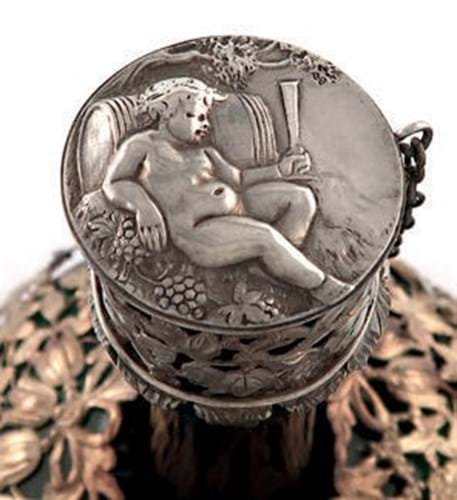
A detail of the silver-mounted cork stopper of the Dutch green glass ‘shaft and globe’ type wine bottle at Woolley & Wallis.
Acquired by Alfred de Rothschild (1842-1918), it appeared in a 1918 valuation schedule at Exbury, catalogued simply as ’a green glass decanter with silver mounts’. A similar piece can be found in the Metropolitan Museum of Art, New York while two very similar bottles, carrying marks for The Hague and Adriaen Van Hoecke, c.1665, were sold at Hannam’s in Hampshire in January 2019.
English entry in New York sale
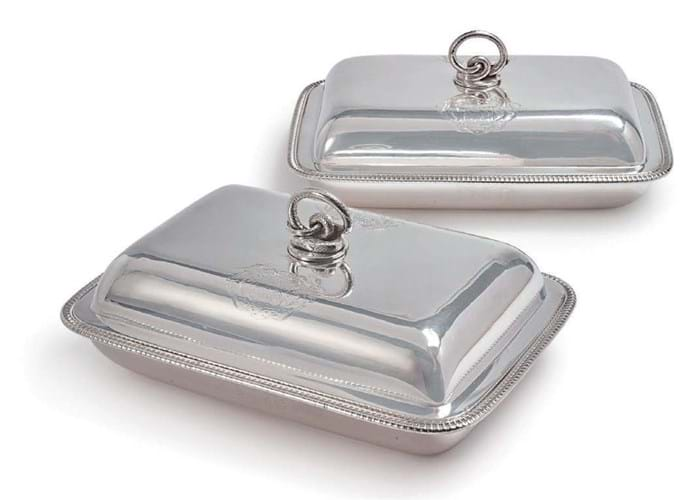
A pair of Paul Storr entrée dishes engraved with armorials, marked for London 1808 and weighing approximately 98oz gross, estimated at $3000-5000 at Stair.
On July 29 Stair in Hudson, New York, will be holding an auction devoted to Silver and Objects of Vertu that will include English, Irish, American, French and Mexican silver as well as a selection of Scandinavian tablewares.
Pictured here is one of the English entries: a pair of 11¾in (30cm) wide Paul Storr entrée dishes engraved with armorials, marked for London 1808 and weighing approximately 98oz gross. They have an estimate of $3000-5000.
Table salts

A pair of Victorian Salters’ Company silver pepperettes marking the Diamond Jubilee, estimated at £300-400 at Bearnes Hampton & Littlewood, Exeter.
A pair of Victorian Salters’ Company silver pepperettes marking the Diamond Jubilee, modelled as Gothic table salts by James Garrard, London, 1897, estimate £300-400 at Bearnes Hampton & Littlewood, Exeter, July 21.
Pleased as Punch
A German silver cream jug in the form of Mr Punch, with import marks for 1901, estimate £200-300 at Smiths of Newent, Gloucestershire July 10.
Bullet teapot target

A George I Scottish bullet form teapot with marks for William Aytoun, Edinburgh, 1725 and assay master Edward Penman, estimated at £2500-3000 at Lawrences of Crewkerne.
A George I Scottish bullet form teapot with marks for William Aytoun, Edinburgh, 1725 and assay master Edward Penman, estimate £2500-3000 at Lawrences of Crewkerne on July 21.
Coffee pot corker
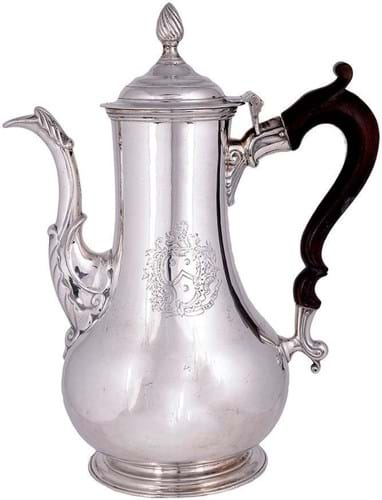
Irish coffee pot with marks for George Hodder of Cork, c.1760, estimated at £3000-5000 at Matthew Barton.
This Irish coffee pot with marks for George Hodder of Cork, c.1760, engraved with a contemporary coat of arms and banner reading LE E 1763, is estimated at £3000-5000 in Matthew Barton’s sale at Olympia Auctions on July 14.



